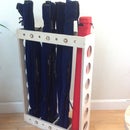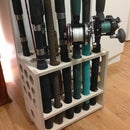Introduction: Eletronics Friendly Office Desk Made With CNC Router and Plywood
This is an update of a traditional office desk design with some features to make it more useful for an electronics laden home office environment:
- Space to run multiple power cables and cords, instead of a single cord keyhole
- A "power supply shelf" under the desk that allows storage and access to surge protectors, power supplies, etc.
- File drawers drawers that can be converted easily to backpack/briefcase storage.
- A curved desktop to allow placement closer to doors (no banging into corners)
This project was made on a CNC router from 3/4, 1/2 , and 1/4 inch plywood. The parts were joined via mortise and tenon joints and pocket screws.
Step 1: Materials and Equipment
Materials
3/4 plywood -2 1/2 sheets
1/2 plywood - 1 sheet
1/4 plywood -1/2 sheet
Iron-on edge banding - approx 50 feet
1 1/2 inch coarse pocket screws- approx 25
1 inch coarse pocket screws- approx 4
24 inch drawer slides -preferably ball bearing - 12
drawer handles - 6
sandpaper -220 grit
wood glue
varnish or other finish of your choice
painter's tape
foam brush if applying varnish
Equipment
CNC Router with 4x8 bed
1/4 upcut and downcut router bits (a single compression bit would be better if your CNC router has the strength for deeper cuts)
1/8 downcut router bit
v-cut router bit (any size)
sander
screwdriver
drill and drill bits
pocket screw jig and drill
iron for applying edgeband
clamps
Software
Any 3D or 2D vector drawing software
CAD software to make cut files
Step 2: Design
I chose to slightly shorten a standard 60 length x 32 width x29 height to 58 x 32 x 29.
I also curved the front of the desk . By making the desktop only 28 inches wide at the corners, the desk can be placed adjacent to a door, as the width is shorter and there is no 90 degree angle to jab into you as you pass. The curved surface creates the impression of a much smaller piece without sacrificing much space.
The top two drawers on each side are fairly shallow, but open quite far. This allows for the horizontal storage of contents, which works better for things like tablets, cell phones, charges, earphones, etc.
Since paper based storage is becoming less important- the two "file" drawers can be converted for other purposes. A "file drawer" can be used for zero, one or two sets of file folders, by simply sliding in/out round steel 3/16" rods through holes inside of the drawers. The drawers are deep and wide enough to hold backpacks and shoulder bags that are commonly brought into the office.
The drawers need to be strong to hold the weight of the modern office payload. To accomplish this, I used mortice and tenon construction for the drawer boxes. with 1/4 inch plywood drawer bottoms.
Instead of a single round power cord keyhole in the desktop, I have added a large rectangular hole with a three cord-hole drop in cover. Note that the top has to be flipped to cut the pocket for the cord-hole- this is the lines in blue in the first photo
Underneath the cord-hole is a 8 inch wide power supply shelf, to keep all the power supplies, surge protectors and other electronics flotsam and jetsam off the floor and desktop. The shelf is slotted to assist in ventilation.
The construction method is my now-favorite: blind mortise joints augmented with pocket screws. The mortise joints ensure that the piece assembles squarely - if your plywood is not warped! The pocket screws add to the strength and simplify assembly - you only need to clamp the part you are attaching and only until the screws are driven - no need to clamp the whole assembly and wait for the glue to dry.
I now try to get all my hardware in advance and include the fitting location in the plans. This allows me to to score the part with a v-bit to ensure an quick and accurate placement of hardware during assembly.
Now I simply draw up the parts in the 2D or 3D design software of choice- I designed this directly into the CAM program (Vcarve), but a dimensionally driven CAD tool is a better choice, as the mortise sizes need to be fine tuned to match the exact plywood thickness which can vary, and parts can share defined offsets, so there is less likely to be a mistake in a mortise/tenon joint location.
When creating the CAD files, I also create small mortise and tenon scrap parts that can be used for a test fit. I will run the file first on the CNC router to ensure my joints will be nice and tight.
Step 3: Cut!
Now we get to let the CNC router do its magic.
I found that several of my sheets of plywood had warped before I had time to do my cuts. Arrgh. While it is possible to flatten the plywood for cutting, it will spring back once removed. This is usually not a problem for smaller pieces, but for a desk this size, it was problematic. I forged on, which later caused some problems on the assembly phase.
I first used the v bit to score marks where the hardware would fit (drawer handle hole centers, draw slide centers. The mortices were all hidden for the 3/4 plywood parts, so I could use the same 1/4 bits I was using for the profile for the dog ear pocket cuts.
Since the drawers were 1/2 and 1/4 plywood, a 1/4 bit would be too big for mortise joint, and too wide for 1/4 plywood width pockets (1/4 plywood is always lees than 1/4), I used my trusty 1/8 bit for these cuts.
Now that all the pieces are cut it is time for assembly.
Step 4: Assembly
- Iron on and trim the edge banding. If you don't have an edge band trimmer tool, you should probably get one for a piece this size.
- Using the pocket screw jig, drill pockets between the mortises on the 3/4 plywood parts.
- Sand and finish the parts, taking care not to apply finish on any surfaces that will be glued. Painter's tape will help here.
- Dry fit the entire assembly
- Attach the hardware to each part. Yes- you can install the drawer slides before assembling the piece!
- Remove and reassemble with glue and pocket screws. Use bar clamps to ensure that the parts are flush. The clamps can be removed after the screws have been tightened.
- Attach the electronics shelf with pocket screws.
-Assemble the drawer boxes with glue. You will either need some clamps or a brad nailer to hold the parts together while drying. It is a good idea to verify that the sides are square before and during nailing or clamping. See the photos for this step to see the drawer box construction. Wait for the glue to fully harden, then attach the slides.
- Drill 3/16 holes for the file holder slides. Cut 3/6 steel rod lengths to slighly smaller than drawer width. Tap into place with a hammer and punch. the fit should be tight, so that no glue is needed, and the rods can be tapped out later if desired. drill two holes per drawer box and countersink to accommodate the screws that will hold the drawer face Slide the drawer boxes in place.
- Starting from the top down, apply a small amount of quick drying glue (hot glue gun, super glue) to the back of the drawer face and attach to box. When glue hardens, clamp and screw drawer faces into place.
- Drill holes for drawer handles and attach. If I had purchased the handles in advance, I would have already drilled the holes on the router!
That's it!
Step 5: Retrospective
The big headache on this project was plywood warp. The larger the sheet being cut, the more warp can be a problem. Since the mortises control how the parts are fit, you cannot tweak the assembly to adjust for the warp. plus some of the mortise cuts can be too deep or too shallow. I was able to fake it by sanding down some of the tenons, and applying some extra clamping force and rubber mallet persuasion, but it was a bit frustrating.
In the future I will bite the bullet and use higher quality plywood (e.g. Baltic birch) and/or pre-cut the the sheet closer to part size- this will allow me to deal with a smaller warp area.
I used a cheap drawer slide from the big box store for the left middle drawer. If you look closely at the side view it appears crooked. But the problem is the slide has a twist!. Once weighted down with stuff the drawer is aligned properly. I should replace this slide, and in the future not scrimp on hardware.













